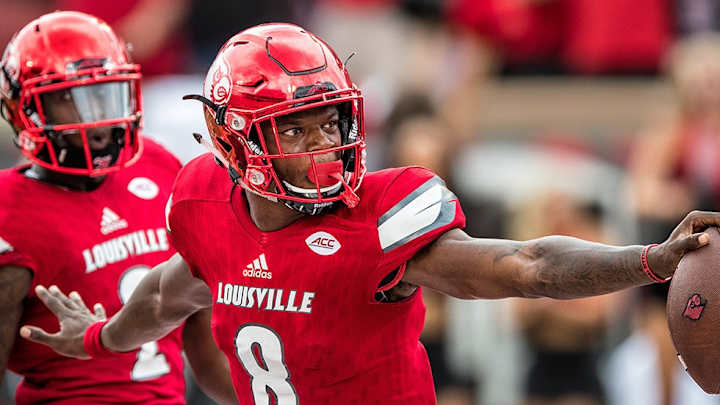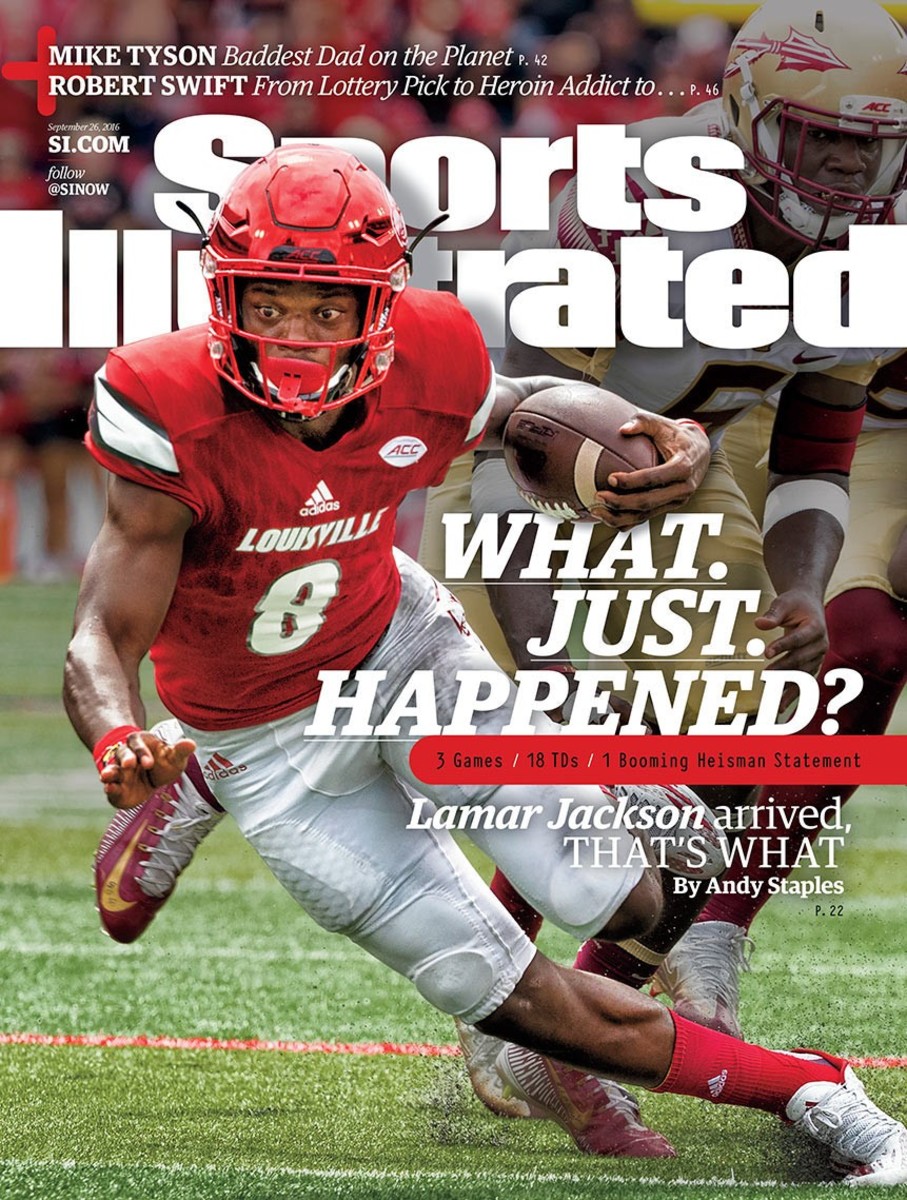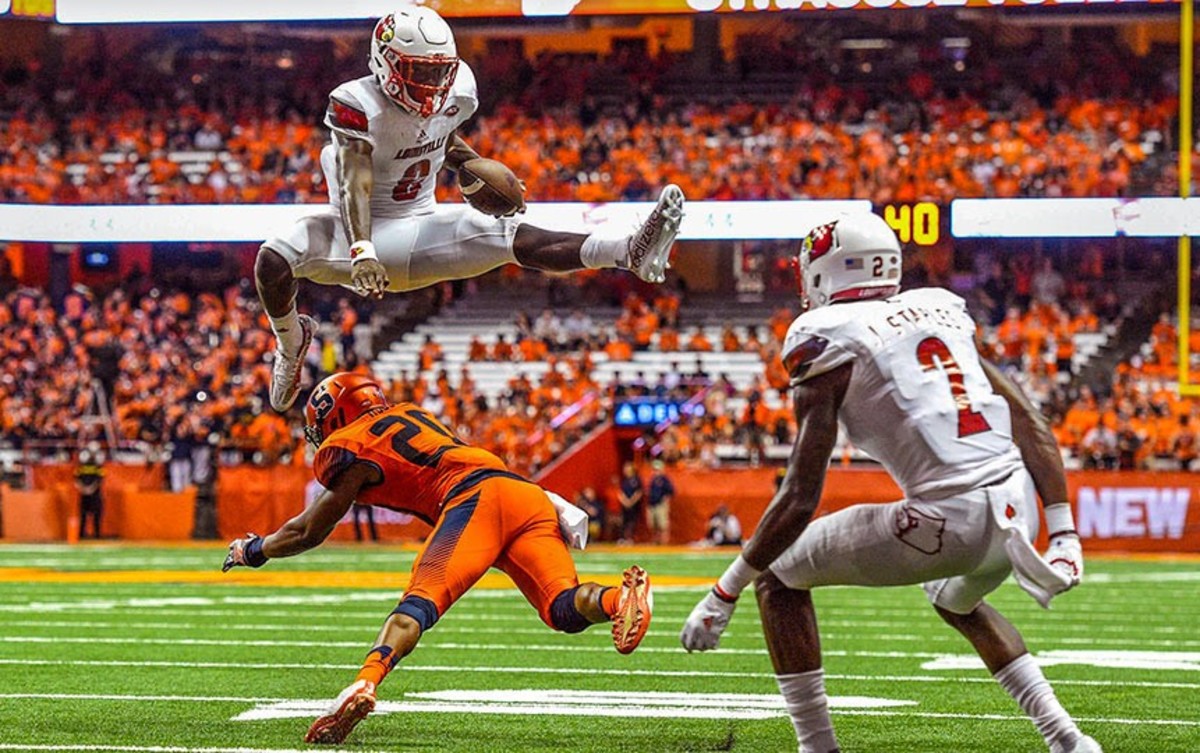The new Superman: Look, up in the Heisman rankings! It's a Cardinal! It's a quarterback! It's Louisville's Lamar Jackson

\n
This story appears in the Sept. 26, 2016, issue of Sports Illustrated. Subscribe to the magazine here.
As Lamar Jackson dropped back, he spotted an opening he wouldn't have tried to exploit a year ago. "I'd have probably been too scared," Louisville's sophomore quarterback says.
Of course the throw would have frightened Jackson then, back when he was only a few months out of Boynton Beach (Fla.) High. It would have scared all but the most experienced quarterbacks. The Cardinals faced third-and-five on their own 42 in the second quarter last Saturday at home against a defense that had dominated the previous five years, giving up 17.0 points per game, second-best in the nation. Florida State, which had already come back from 21 down to beat Ole Miss earlier in the season, had just shaved Louisville's 14-point lead to four. Before the snap Jackson looked across the line of scrimmage and scanned the D in the sequence coach Bobby Petrino preaches.
Front: Three down linemen, nosetackle head up on the center.
Secondary: Cover 2.
Personnel: Dime, with two linebackers and six defensive backs.
Jackson knew that to hit senior receiver James Quick on a deep slant, he would have to arc the ball over one defender and lead Quick away from another. Considering the high degree of difficulty, the 2015 version of Jackson would likely have pulled the ball down and taken off. The 2016 version? "I knew I could put it over the defender's head," Jackson says. The 6' 3" 205-pounder planted his back foot and flicked his right wrist. The ball sailed past the outstretched fingers of leaping safety Nate Andrews and settled into the hands of Quick, who ran away from cornerback Marquez White for a 30-yard gain. That conversion led to a touchdown five plays later, and the Seminoles never threatened again. Jackson finished with 216 yards passing, 146 rushing and five total touchdowns in a 63–20 victory. Florida State, winner of three of the past four ACC titles, hadn't endured a butt-whipping so bad since 1981.
Lamar Jackson fears nothing on the football field because he understands so much more than he ever has. This should terrify opposing defensive coordinators. Jackson already has the speed to outrace secondaries. If he continues to develop into the passer Petrino envisions, there may be no way to stop him. On Sunday night in Huntington, W.Va., the coaches of Louisville's next opponent watched Jackson eviscerate the Noles. Marshall defensive ends coach Sean Cronin thought back to his time as a Florida graduate assistant when the Gators had Tim Tebow and Cam Newton on the same roster. "I've seen some Heisman winners," Cronin says. "And that's what they look like."
FIAMMETTA: Louisville makes big leap in Power Rankings after Week 3
Is this what Petrino had hoped for in 2007, when he took over the Falcons with Michael Vick? The 55-year-old coach isn't particularly interested in dredging up the season he spent in the NFL, which happened to be the one when Vick was sentenced to 23 months in federal prison for offenses related to dogfighting. "We had Mike in OTAs, and he was really winging it around," Petrino says. "I was enjoying it, and then he was gone." Like Vick, Jackson can befuddle a defense with his feet; he spun and left two Seminoles on the ground to cap a 47-yard fourth-quarter touchdown run. And like Vick, he can effortlessly launch deep balls. After the win on Saturday, which vaulted unbeaten Louisville from No. 10 in the AP poll to third, Vick tweeted: "Lamar Jackson 5x better than what I was at V-Tech.... Enough said!! #future"
Five times better? Jackson won't even contemplate the thought. Still, Vick is only one comparison. Jackson piles up touchdowns (18 through three games) the way Johnny Manziel did when he won the Heisman in 2012 at Texas A&M. Jackson looks like an even faster Marcus Mariota, who won the Heisman at Oregon in '14. Meanwhile, Jackson's success and his South Florida-to-Louisville journey run parallel to former Cardinal and current Viking Teddy Bridgewater. "You think in your career you'll never get another one like Teddy," athletic director Tom Jurich says. "Then this guy shows up."

David E. Klutho
*****
This is exactly what Jackson envisioned when he signed to play for Louisville. He knew other schools coveted his Lamborghini-like acceleration, but he also knew what that meant. If he didn't get moved to safety or receiver, he'd get crammed into some simplified scheme that had him counting the number of defenders in the box and then deciding whether to execute the read-option or throw to wideouts running a dumbed-down route tree. Jackson never wanted that. That's why his finalists last year were Louisville, where Petrino uses an NFL-style offense, and Florida, where coach Jim McElwain was installing an equally diverse scheme. "I wanted to be in a pro-style system, not just a—how should I say it?—pistol or spread all the time," Jackson says (as diplomatically as possible). This is why when Louisville coaches had Jackson return punts during one camp practice last year, a call from Jackson's mother, Felicia James, ensured it wouldn't happen again. Jackson is a quarterback and a quarterback only.
Now Petrino doesn't even want him to be a running quarterback—though he has dashed for 464 yards in three games, second most in the country. "Our job is to get Lamar to be a drop-back passer, to be able to throw the football and read progressions and dump the ball down, which he's done a really good job of these three games," Petrino says. "Then his athletic ability will show up even more because people have to play coverages to stop the passing game."
In other words, the better Jackson can throw, the easier it will be for him to run. A defense that must drop eight into coverage can't also spy him with a linebacker or a safety. If a receiver pops open, Jackson can deliver a strike. If not, he can race for a first down before a defender is close enough to touch him. This is especially true now that Louisville's offensive line has grown into a group that can protect Jackson in the pocket and open holes for him on the ground. Through three games Jackson ranks third in the nation in yards per pass attempted (11.1) and No. 5 in yards per rush (9.5), while his 18 TDs through the team's first three games ties the record.
Jackson can still get much better, though. After prodding from his coaches, he seemed more at ease on Saturday with checking into different plays based on his pre-snap read. If he masters this skill, the Cardinals' offense might make a scoreboard explode.
BAUMGAERTNER: Week 3 Takeaways: Biggest things we learned
*****
Jackson didn't know if he could reach this point. Shortly after he arrived at Louisville in the summer of 2015, he picked up his playbook. It was huge. At Boynton Beach High coach Rick Swain had drawn plays on the board. Now Jackson was expected to memorize the equivalent of an encyclopedia volume. And, says Jackson, "It was a foreign language." He would call his mother and complain. Maybe he couldn't do this. "This is too much like studying," Jackson whined. James would hear none of it. She told him he'd never digest the playbook if he tried to swallow it whole. If he broke up his study into 30-minute chunks, he could focus on one aspect of the offense at a time.
He began learning, but not fast enough for Petrino. The Cardinals used three quarterbacks in 2015—Jackson, then-sophomores Kyle Bolin and Reggie Bonnafon. While Petrino knew Jackson had the highest ceiling, he couldn't reasonably expect that a freshman could master his playbook in two months. "We knew that his athletic ability and his ability to throw the ball were very unique," Petrino says. "The question became, what can you teach him in a short amount of time? So we put packages together for him. And he did a really good job of understanding those packages. But you couldn't install the whole offense."
So Jackson relied on his instincts and athleticism. "There were times last year that we'd end up calling a play, and he wouldn't know what the play was," says quarterbacks coach Nick Petrino, Bobby's son. "You could see from film that he'd be looking at the wrong spot. We'd have guys wide open, and he wouldn't even know where to look." In spite of this, Jackson made plays. He threw for 307 yards and three touchdowns in a 41–21 loss at Florida State. He threw for 130 yards and ran for 186 in a 38–24 win at Kentucky. After the Cardinals had time to pause before facing Texas A&M in the Music City Bowl, they finally felt comfortable letting Jackson run the entire offense. Jackson's performance in a 27–21 win against the Aggies (227 yards and two touchdowns passing; 226 yards and two touchdowns rushing) foreshadowed what could happen once he had full command.
*****

David E. Klutho
Back in Boynton Beach, Swain could only nod his head and smile. He had seen all of this coming in early 2013. At one of the first team meetings his players raved about the kid who had just transferred in from nearby Santaluces High, after watching video clips of their new classmate. Swain pointed out that Jackson hadn't yet scored a single touchdown for the Tigers. Jackson muttered that he would score plenty. Swain and Jackson have told this story often, but Swain never told Jackson what he said when Jackson began practicing later that spring. On one play, Swain watched Jackson throw an out route "like a BB"; on the next, he tucked the ball and rocketed through the defense. Swain looked at an assistant: "We've got to change offenses." That day he scrapped the Wing-T and created a system that incorporated spread, pistol and veer concepts to capitalize on Jackson's speed and arm strength.
Later that spring Derek Williams, who has run the Sunshine Preps scouting service for 16 years, was plowing through stacks of game film when he saw Jackson and stopped. "With Lamar, it was his ability to get to full speed in literally half a step," Williams says. "When he sees an opening, he's able to get to full speed in a way that very few guys can." Or as Jurich says, "He plants his foot, and the party's over."
Jackson shone in talent-rich South Florida, but he didn't always win. Florida State tailback Dalvin Cook's Miami Central High team pounded Boynton Beach 55–37 in the first round of the Class 6A playoffs in 2013. Jackson threw for 248 yards and two touchdowns and ran for 194 yards and two more, but he didn't have enough talent around him to beat the loaded Rockets. Last week Cook wondered aloud what Jackson could do if surrounded by better teammates. On Saturday he got his answer.
NIESEN: Three thoughts on Louisville's rout of Florida State
It was in high school that Jackson also first displayed his unflappable nature. During his senior year several special teams' failures put the Tigers behind Coconut Creek High 58–57 with 50 seconds remaining. "I was stuttering a little bit," Swain says. "I was upset." Jackson wasn't. "He looked at me and said 'Coach. Calm down. We've got this.' And he just started laughing," Swain says. "Like it was a day out at the park." On third-and-12 from the Boynton Beach 49, Jackson scrambled right and hit Chauncey Mason for a 47-yard gain. Two plays later Jackson dived over the offensive and defensive lines for the game-winning touchdown. This should seem all too familiar to Syracuse cornerback Cordell Hudson, whom Jackson hurdled en route to the end zone during the Cardinals' 62–28 win on Sept. 9.
Jackson still laughs in the face of adversity. "It's life," he says. "Be happy. God gave you a breath to breathe every day. You don't need to be mad about nothin'." Jackson occasionally will break his rule, but only for self-improvement. "I'll be mad at myself," he says. "But I'm just doing that to get myself better—to motivate myself." Though he handed out high marks to his teammates, he gave himself a D against Florida State because he threw an interception and missed several reads.
That leads to an obvious question. If that's a D, what does an A look like? Jackson points to the wall in Louisville's team meeting room, where 12 offensive goals are charted for each game. The Cardinals met 11 of them on Saturday. "See the board right there? See how there's an empty slot?" Jackson says. "When all that's filled, I'll be like, All right, we did what we were supposed to do. But it's not filled."
Not yet.
